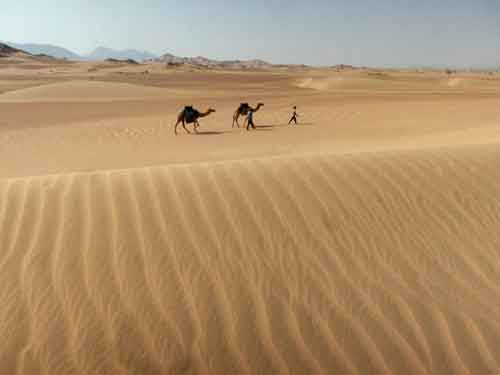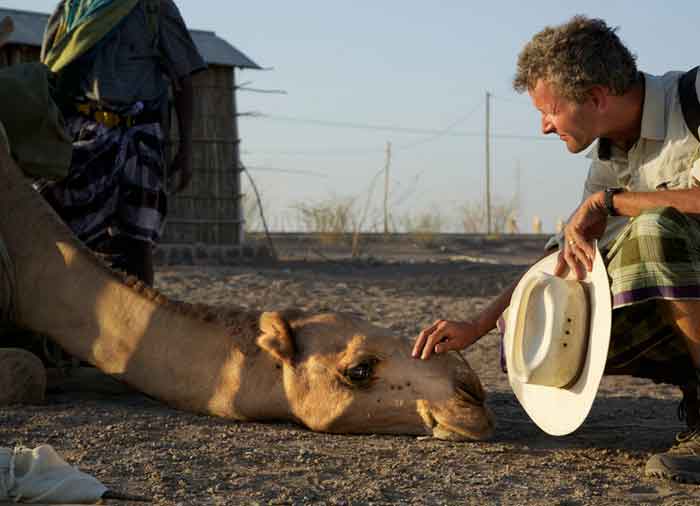By John Pint
 Several
years ago National Geographic Magazine published what struck me as an
absolutely astounding story. It stated that every single human being on
the face of the earth today is a descendant of a rather small number
(perhaps only a few hundred) people who emigrated out of Africa around
60,000 years ago, embarking on a trek that would quite literally take
them to the very ends of the earth. This conclusion was based on
advances in genetics and DNA samples taken worldwide. Several
years ago National Geographic Magazine published what struck me as an
absolutely astounding story. It stated that every single human being on
the face of the earth today is a descendant of a rather small number
(perhaps only a few hundred) people who emigrated out of Africa around
60,000 years ago, embarking on a trek that would quite literally take
them to the very ends of the earth. This conclusion was based on
advances in genetics and DNA samples taken worldwide.
The fact that we are all descended from Africans impressed me,
but I was especially interested in the fact that most of our ancestors
had crossed the Bab Al Mandeb Strait over to the Arabian Peninsula and
worked their way north through what is now Saudi Arabia.
This resonated with my own thirteen-year study of Saudi Arabia’s caves.
I knew that the principal sources for water and shelter (from heat,
cold and especially from wind) along vast stretches of western Arabia
are lava tubes: caves up to twenty kilometers long and 40 meters wide
which are located (sometimes in great numbers) among the 80,000 square
kilometers of lava fields near which many of those early forebears must
surely have passed.
That map of mankind’s great migration must have impacted many people
around the globe, among them a man named Paul Salopek, one of the
world’s great journalists and two-time winner of the coveted Pulitzer
Prize. Salopek really took the story of humanity’s long walk to heart.
Following clues provided by DNA studies, he mapped out a route all the
way from Ethiopia to Patagonia—21,000 miles—and proposed to walk all
that distance (except for a couple short stretches over water) during
seven years of his life.
Why does he want to do this?
“Long-term storytelling,” he replied. “It’s not an athletic event… I
want to examine the great issues of our day at three miles an hour… to
watch the world around me and to get into people’s lives.”
Salopek started his journey in January, 2013, crossed the Red Sea and,
accompanied by a Bedu and two pack camels, slowly walked his way north
through Saudi Arabia, always talking to local people, listening to
their worries, hopes and dreams, and reporting short, fascinating
dispatches every few days.

A'urta
gets a reassuring head scratch while being loaded for the trail.
PHOTOGRAPH BY JOHN STANMEYER-VII
“I am on a journey,” he
says. “I am in pursuit of an idea, a story, a chimera, perhaps a folly.
I am chasing ghosts. Starting in humanity’s birthplace in the Great
Rift Valley of East Africa, I am retracing, on foot, the pathways of
the ancestors who first discovered the Earth at least 60,000 years ago.
This remains by far our greatest voyage.”
“We know so little about them… They straddled the strait called Bab el
Mandeb—the ‘gate of grief” that cleaves Africa from Arabia—and then
exploded, in just 2,500 generations, a geological heartbeat, to the
remotest habitable fringe of the globe.
Millennia behind, I follow.”
At the time of this writing, Paul Salopek is somewhere close
to Syria (not too close, I hope), having recently walked past Jordan’s
Wadi Rum (through which Lawrence of Arabia sneaked up on the Turks) and
the famed Nabatean tombs of the once Lost City of Petra.
When I contacted the indefatigable walker regarding some of the curious
features along his route through Saudi Arabia (for example, the ruins
of Roman Therms
or bathhouses along the Red Sea coast and the Nazca-like “kites”
which Neolithic Man used to trap oryxes and gazelles), he noticed I was
living in the Mexican town of Zapopan and told me that he also had
lived there:
“I grew up on the fringe of Colonia Seattle in Zapopan,” he said. “I
would go drop fishing lines down holes in Agua Azul Park to fish for
rats. Took buses into the Barranca de Oblatos to go hunting with my
neighbor Lalo's hand-made flintlock. It was a fairly wild area back
then. We used river stones as ammo and never hit anything… My
playgrounds were the guamuchil
trees, garbage-strewn lots and lush green corn
fields around the edge of the city. Some of my boyhood friends died
young of curable diseases. We had fun.”
Salopek’s Mexican adventures didn’t stop there.
“Some years ago, I rode a mule from Douglas, Arizona, to Michoacán,
down the spine of the Sierra Madre. A memorable journey.” The
story of this 2,090 kilometer odyssey, which retraced the route
explored by Carl Lumholtz in 1890, is told in the book Sierra Madre
Pilgrimage, By Paul Salopek, Photographs by Maria Stenzel.
In Literature as Lucha Libre, a lesson on writing for The American
Scholar, Salopek reflects on a perhaps surprising aspect of his youth
in Colonia Seattle:
“My greatest literary inspiration at this time was a comic book called
Kalimán. Kalimán was a vaguely Sikh superhero in white tights who spoke
Spanish. (These) adventures introduced the notions of cliffhangers and
the second act. Kalimán was always going into trances, slowing his
metabolism down into deathlike comas. Even then, as a child, this
struck me as the perfect Mexican super power, a defense against one
billion years of fatalism.
Soon I was drawing my own. My cartoons featured schizoid child geniuses
who lived on desert islands and a race of woolly mammoths who lived
underground. I rented out my comics, thus discovering editing and
royalties. Kids in
huaraches paid me 20 centavos to sit on the dirt sidewalk
outside my house, page through stacks of my crude narratives, and offer
mostly negative textual analyses.
I asked him how much his years in Mexico had influenced his life.
“Mexico
informs everything I do,” he replied, “because it's my childhood. And
like childhood, that Mexico of mule-plowed fields is fading fast. Maybe
it's gone. I grew up between 1870 and 1970. For better or worse NAFTA
closed that gap. 'El Mexico que se nos fué’ and all that. It occurs to
me from time to time that maybe I'm out looking for the older Mexico
elsewhere. Don't we all do this? And isn't it always a lunatic
enterprise?”
Well, I started this article with the intention of
describing Paul Salopek’s long walk, but I ran into more than I
bargained for. But if you didn’t know before, now you do: here is
someone you ought to investigate on your own. You’ll enjoy what you
find! As Ken Armstrong said in the Seattle Times (that’s the other
Seattle, eh?):
“Paul doesn’t take shortcuts. To tell a story of
civil war, he took a five-week trip down the Congo River, mostly by
canoe. To tell a story of the people in Mexico’s Sierra Madre, he
traveled 1,300 miles by mule. He crosses mountain passes, deserts and
seas, all to tell us stories.”
Want to read some of those stories? Go to Out of
Eden Walk,
have a look at Paul Salopek’s latest dispatches, and if you like what
you see, sign up right there for regular email notifications of his
latest reports. In my opinion, you’re guaranteed six more years of
reading pleasure…and don’t forget: about five years from now, Salopek
should be walking the length of Mexico and hopefully will pass through
Jalisco…but this time he won’t be riding a mule.
|

